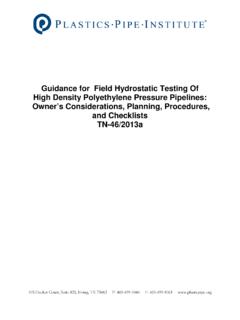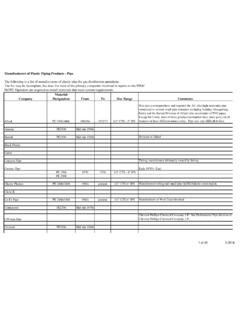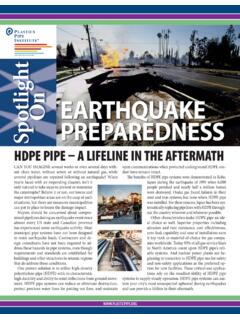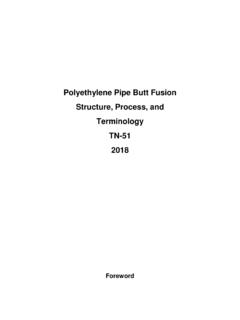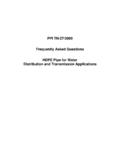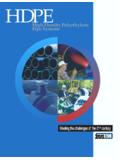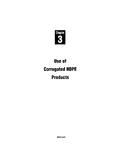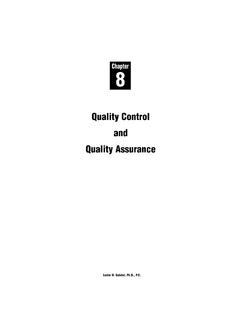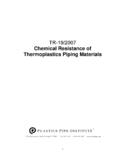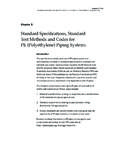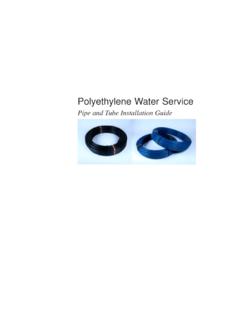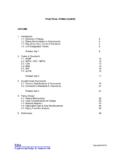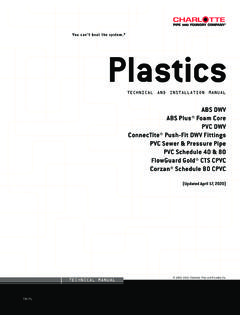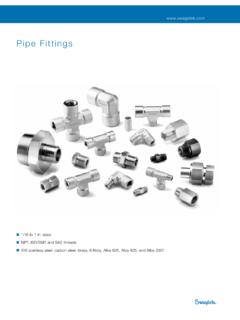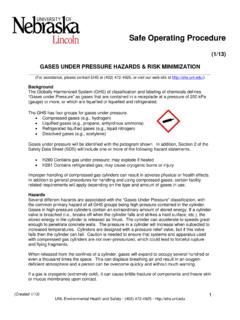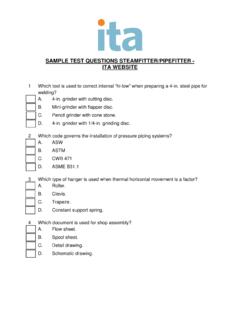Transcription of Chapter 6 - Design of PE Piping Systems - plastic pipe
1 Chapter 6 Design of PE Piping Systems155 Chapter 6 Design of PE Piping SystemsIntroductionDesign of a PE Piping system is essentially no different than the Design undertaken with any ductile and flexible Piping material. The Design equations and relationships are well-established in the literature, and they can be employed in concert with the distinct performance properties of this material to create a Piping system which will provide very many years of durable and reliable service for the intended the pages which follow, the basic Design methods covering the use of PE pipe in a variety of applications are discussed. The material is divided into four distinct sections as follows:Section 1 covers Design based on Working pressure Requirements. Procedures are included for dealing with the effects of temperature, surge pressures, and the nature of the fluid being conveyed, on the sustained pressure capacity of the PE pipe .
2 Section 2 deals with the hydraulic Design of PE Piping . It covers flow considerations for both pressure and non- pressure 3 focuses on burial Design and flexible pipeline Design theory. From this discussion, the designer will develop a clear understanding of the nature of pipe /soil interaction and the relative importance of trench Design as it relates to the use of a flexible Piping , Section 4 deals with the response of PE pipe to temperature change. As with any construction material, PE expands and contracts in response to changes in temperature. Specific Design methodologies will be presented in this section to address this very important aspect of pipeline Design as it relates to the use of PE 1551/16/09 9:56:52 AMChapter 6 Design of PE Piping Systems156 This Chapter concludes with a fairly extensive appendix which details the engineering and physical properties of the PE material as well as pertinent pipe characteristics such as dimensions of product produced in accordance with the various industry standards.
3 1561/16/09 9:56:52 AMChapter 6 Design of PE Piping Systems157 Section 1 Design Based on Required pressure CapacityPressure RatingThe methodology for arriving at the standard pressure rating, PR, for PE pipe is discussed in detail in Chapter 5. The terms pressure rating (PR), pressure class (PC), are used in various consensus standards from ASTM, AWWA, CSA and others to denote the pipe s capacity for safely resisting sustained pressure , and typically is inclusive of the capacity to resist momentary pressure increases from pressure surges such as from sudden changes in water flow velocity. Consensus standards may treat pressure surge capacity or allowances differently. That treatment may vary from the information presented in this handbook. The reader is referred to the standards for that specific 1-1 and 1-2 utilize the Hydrostatic Design Stress, HDS, at 73 F (23 C) to establish the performance capability of the pipe at that temperature.
4 HDS s for various PE pipe materials are published in PPI TR-4, PPI Listing of Hydrostatic Design Basis (HDB), Hydrostatic Design Stress (HDS), Strength Design Basis (SDB), pressure Design Basis (PDB) and Minimum Required Strength (MRS) ratings for Thermoplastic Piping Materials . Materials that are suitable for use at temperatures above 100 F (38 C) will also have elevated temperature Hydrostatic Design Basis ratings that are published in PPI TR-4. The PR for a particular application can vary from the standard PR for water service. PR is reduced for pipelines operating above the base Design temperatures, for pipelines transporting fluids that are known to have some adverse effect on PE, for pipelines operating under Codes or Regulations, or for unusual conditions. The PR may be reduced by application of a factor to the standard PR.
5 For elevated temperature applications the PR is multiplied by a temperature factor, FT. For special fluids such as hydrocarbons, or regulated natural gas, an environmental application factor, AF, is applied. See Tables 1-2 and Appendix, Chapter reader is alerted to the fact that the form of the ISO equation presented in Equations 1-1 and 1-2 has changed from the form of the ISO equation published in the previous edition of the PPI PE Handbook. The change is to employ HDS rather than HDB, and is necessitated by the additional ratings available for high performance materials. In the earlier form of the ISO equation, PR is given as a function of the HDB, not the HDS as in Equations 1-1 and 1-2. This difference is significant and can result in considerable error if the reader uses the Environmental Applications Factors given in Table 1-2 as the Design Factor in the HDB form of the ISO 1571/16/09 9:56:52 AMChapter 6 Design of PE Piping Systems158(1-1)(1-2)WHEREPR = pressure rating, psiHDS = Hydrostatic Design Stress, psi (Table 1-1)AF = Environmental Application Factor (Table 1-2)NOTE.
6 The environmental application factors given in Table 1-2 are not to be confused with the Design Factor, DF, used in previous editions of the PPI Handbook and in older = Service Temperature Design Factor (See Appendix to Chapter 3)DR = OD -Controlled pipe Dimension Ratio(1-3)DO = OD-Controlled pipe Outside Diameter, = pipe Minimum Wall Thickness, = ID -Controlled pipe Dimension Ratio(1-4) 3 pipe Diameter for OD Controlled pipe OD-controlled pipe is dimensioned by outside diameter and wall thickness. Several sizing Systems are used including IPS, which is the same OD as IPS steel pipe ; DIPS, which is the same OD as ductile iron pipe ; and CTS, which is the same OD as copper tubing. For flow calculations, inside diameter is calculated by deducting twice the wall thickness from the outside diameter. OD-controlled pipe standards include ASTM D2513, ASTM D2737, ASTM D2447, ASTM D3035, ASTM F714, AWWA C901, AWWA C906 and API 15LE.
7 (3,4,5,6,7,8,9,10) The appendix provides specific dimensional information for outside diameter controlled polyethylene pipe and tubing made in accordance with selected ASTM and AWWA standards. Equation 1-1 may be used to determine an average inside diameter for OD-controlled polyethylene pipe made to dimension ratio (DR) specifications in accordance with the previously referenced standards. In these standards, pipe dimensions are specified as average outside diameter and, typically, wall thickness is specified as a minimum dimension, and a +12% tolerance is applied. Therefore, an average ID for flow calculation purposes may be determined by deducting twice the average wall thickness (minimum wall thickness plus half the wall tolerance or 6%) from the average outside diameter.
8 Eq. 1-1 Where, DA = pipe average inside diameter, in DO = pipe outside diameter, in DR = dimension ratio tDDRO Eq. 1-2 t = pipe minimum wall thickness, in pipe Diameter for ID Controlled pipe Standards for inside diameter controlled pipes provide average dimensions for the pipe inside diameter that are used for flow calculations. ID-controlled pipe standards include ASTM D2104, ASTM D2239, ASTM F894 and AWWA C901. (11,12,13) The terms DR and IDR are used with outside diameter controlled and inside diameter controlled pipe respectively. Certain dimension ratios that meet an ASTM-specified number series are standardized dimension ratios, that is SDR or SIDR. DI = ID-Controlled pipe Inside Diameter, 1-1 Hydrostatic Design Stress and Service Temperatures Property Standard PE 2606, PE2706 PE 2708, PE 3608, PE 3708, PE 4608 PE 3710, PE 4710 Hydrostatic Design Stress, HDS at 73 F (23 C)ASTM D2837 & PPI TR-3630 psi ( MPa)800 psi ( MPa)1000 psi ( MPa)Maximum recommended operating temperature for pressure Service*-140 F (60 C)140 F (60 C)140 F (60 C)Maximum recommended operating temperature for Non- pressure Service-180 F (82 C)180 F (82 C)180 F (82 C)* Some PE Piping materials are stress rated at temperatures as high as 180 F.
9 For more information regarding these materials and their use, the reader is referred to PPI, TR-4. 5 tDIDRI= Eq. 1-6 DI = ID-Controlled pipe Inside Diameter, in. Table 1-1: Hydrostatic Design Basis ratings and Service Temperatures Property ASTM Standard PE 3408 PE 2406 HDB at 73 F (23 C) D 2837 1600 psi ( MPa) 1250 psi ( MPa) Maximum recommended temperature for pressure Service 140 F (60 C)* 140 F (60 C) Maximum Recommended Temperature for Non- pressure Service 180 F (82 C) 180 F (82 C) * Some polyethylene Piping materials are stress rated at temperatures as high as 180 F. For more information regarding these materials and their use, the reader is referred to PPI, TR-4 The long-term strength of thermoplastic pipe is based on regression analysis of stress-rupture data obtained in accordance with ASTM D2837. Analysis of the data obtained in this procedure is utilized to establish a stress intercept for the material under evaluation at 100,000 hours.
10 This intercept when obtained at 73 F is called the long-term hydrostatic strength or LTHS. The LTHS typically falls within one of several categorized ranges that are detailed in ASTM D2837. This categorization of the LTHS for a given pipe material establishes its hydrostatic Design basis or HDB. The HDB is then utilized in either equation 1-3 or 1-4 to establish the pressure rating for a particular pipe profile by the application of a Design factor (DF). The DF for water service is , as indicated in Table 1-2. Additional information regarding the determination of the LTHS and the D2837 protocol is presented in the Engineering Properties Chapter of this handbook. Table 1-2: PE pipe Design Factors (DF) pipe Environment Design Factor (DF) at 73 F (23 C) Water; Aqueous solutions of salts, acids and bases; Sewage; Wastewater; Alcohols; Glycols (anti-freeze solutions); Nitrogen; Carbon dioxide; Methane; Hydrogen sulfide; non-federally regulated applications involving dry natural gas other non-reactive gases LPG vapors (propane; propylene.)
